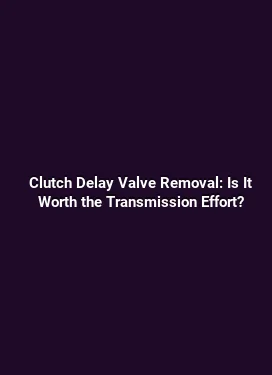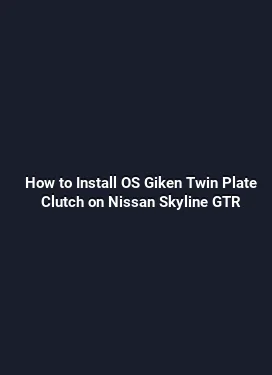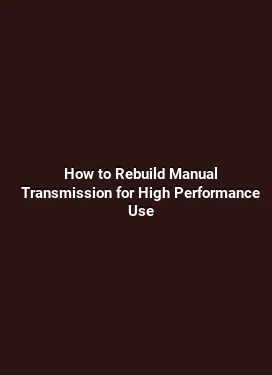Best Budget LSD Options Under $800 for Drift and Track Use
Overview of Budget Limited-Slip Differentials and Drivetrain Compatibility

When building a budget-friendly drift or track-ready machine, the drivetrain plays a pivotal role in translating tire grip into controlled power delivery. Limited-slip differentials (LSDs) come in several varieties, each with distinct torque split, response, and durability characteristics. For under $800, enthusiasts often weigh clutch-type LSDs, helical or cone-type torsen-style units, and occasionally pre-owned or remanufactured options that fit tight budgets without compromising the core purpose: predictable power transfer during cornering and mid-corner traction management. The key is to match the LSD to the vehicle’s weight, horsepower, and the driver’s preferred handling style, while also considering transmission compatibility, gear ratios, and the diff’s bulk/clearance in the housing.
In practice, a well-chosen budget LSD enhances drift initiation, reduces wheel spin on exit, and improves stability during aggressive steering inputs on a track surface. Budget options often emphasize durability and straightforward installation rather than the refined, high-end performance found in premium units. Vehicle platforms with common final-drive setups—such as many inline-four sport coupes, hatchbacks, and compact sedans—present affordable pathways to meaningful grip improvements when paired with a robust installation plan and starter maintenance practices.
Key Criteria for Selecting an Inexpensive LSD
Choosing an LSD within an under-$800 budget requires balancing several practical considerations. First, assess the differential’s type: clutch-type units deliver strong lockup for consistent behavior during repeated corner exits but may wear faster under aggressive drift use; helical/torsen-style units provide smooth engagement with lower wear but can add some lag in extreme angles; cone-type LSDs can offer a middle ground with predictable lockup, particularly in limited-slip configurations, while being more affordable to service in some markets.
Next, verify compatibility with the vehicle’s axle shafts, mounting points, pinion depth, and payload. Some budget LSDs are designed for universal fit with minor machining, while others require precise vehicle-specific housings. Consider the differential’s gear ratios, starter motor clearance, and the possibility of shifting choices in the final drive, as these elements influence how the car behaves at speed and how quickly the tires can scrub into grip. Finally, evaluate serviceability: availability of replacement clutch plates, friction materials, seals, and easy access to a qualified technician for setup and break-in procedures can make a modestly priced unit perform reliably over time.
Popular Budget LSD Options Under $800: An In-Depth Look
The market for affordable LSDs frequently centers on widely available models from manufacturers that cater to grassroots racers. While some options may be used or remanufactured, a number of new, budget-friendly LSDs exist that balance cost with reliable performance. Below are representative categories and examples commonly found in the under-$800 segment, along with practical notes on what to expect in terms of driving feel, durability, and maintenance needs.
Clutch-Type LSDs: Strong Lock Power and Tunable Behavior

Clutch-type limited-slip units are popular for drift and track use because they deliver a pronounced lockup behavior when applying throttle. On a budget, look for units that use a compact clutch pack with standardized friction materials, making replacement straightforward after wear or during routine maintenance. A typical feature set includes a preload adjustment option, multiple spring settings, and the ability to tune the torque bias to favor either the inside or outside wheel under cornering. In practice, you’ll notice sharper transitions when accelerating out of corners and more predictable behavior under throttle lift during entry, which helps a driver maintain line control at the limit.
Installation considerations for clutch-type LSDs involve ensuring proper clutch pack seating, correct preloading, and a precise backlash measurement. Improper preload or misalignment can cause chatter, vibrations, or premature wear. For track days and drift sessions, a break-in procedure—gentle, sustained drives at moderate speeds followed by several high-load runs—helps the friction surfaces conform to the ring gear and pinion. Budget options often require attention to oil compatibility and friction material quality, as degrading clutch material will elevate slip or harsh engagement. Regular inspection of the springs, retainers, and wear plates is advisable after the first few heavy-use sessions.
Cone-Type and Helical LSDs: Smooth Engagement Without Excess Wear
Cone-type and helical (or torsen-style) LSDs tend to provide smoother engagement than clutch-type variants, with less abrupt lockup and reduced maintenance per cycle. On a budget, these units often rely on precisely machined gears and a contact pattern that promotes even load distribution. The result is consistent behavior under varied grip levels, making them a favored choice for street-to-track transitions and drift practice where a driver benefits from steady, predictable feedback. For track use, these units can deliver dependable traction during mid-corner exits while preserving a balance that helps prevent snap oversteer in high-horsepower builds.
Installation considerations include ensuring gear mesh quality and proper gear oil selection to minimize noise and heat. Helical/LSDs can be more forgiving during installation, but still require careful setup of preload (where applicable) and a confirmatory road test to validate engagement characteristics. Maintenance tends to be less frequent than clutch-type units, though periodic oil changes and checks for unusual wear remain essential to maximize longevity on a budget build.
Practical Installation Strategies and Tuning Tips
Maximizing the benefits of an affordable LSD begins with a methodical installation process and a clear plan for drivetrain tuning. Start with clean mating surfaces, precise torque specs for fasteners, and a calibrated procedure for seating the unit into the differential housing. If the kit includes new bearings or shims, replace them to ensure proper preload and align the diff properly within the housing. The absence of a professional alignment can invite uneven wear and compromised engagement characteristics, particularly under high lateral loads on a drift surface.
Once installed, the break-in phase is critical. For most budget LSDs, a conservative break-in that involves steady driving under varied RPMs and a few controlled power cycles helps seat the gears without introducing heavy chatter. After the break-in, perform a controlled test run on a closed course or a safe track environment. Observe how the car responds to gas application, throttle lift, and corner entry under different speeds. Use these observations to fine-tune the vehicle’s suspension balance, tire pressures, and steering input strategy to complement the LSD’s behavior.
Tuning Notes: Torque Bias, Suspension Interaction, and Tire Grip
Torque bias is a critical factor. Some budget LSDs let you adjust how aggressively the differential locks under power. A bias toward the outside wheel can reduce understeer in tighter corners, while bias toward the inside wheel can increase steering response but may raise the risk of wheel spin if the tire surface is compromised. Suspension stiffness and alignment play a substantial role in how the LSD translates power into motion. A stiffer rear suspension generally enhances yaw stability and helps the differential maintain traction at the exit of corners, while a softer setup may require a different bias setting to achieve the desired drift angle without sacrificing straight-line stability.
Tire choice remains a keystone. In drift-friendly setups, wider rear tires can improve grip and predictability, but you must balance them with the car’s power and weight. In a track day context, maintaining consistent contact patches and even wear across tires reduces unpredictable grip losses that could mask the LSD’s true behavior. Regular tire inspections and pressure adjustments based on track temperature and humidity help you exploit the LSD’s capabilities without compromising safety.
Maintenance, Durability, and Longevity on a Budget
Even budget LSDs require a maintenance mindset. Regular inspections of seals, oil, and friction surfaces go a long way toward prolonging service life. For clutch-type units, monitor clutch wear by checking the engagement feel and any unusual slipping. For torsen-type and cone-type units, listen for whining or grinding sounds that could indicate bearing wear or misaligned gear meshing. Oil selection matters: choose gear oil with the right viscosity and additive package for the specific LSD type, and follow manufacturer recommendations for intervals between changes. In some cases, a dedicated LSD oil or additive can improve engagement feel and thermal stability during long sessions on a track surface.
Durability follows usage patterns. High-repetition throttle applications, aggressive corner exits, and sustained cornering can accelerate wear in any LSD. For budget builds, proactive maintenance—carrying a spare set of seals, friction plates, and basic shims—helps reduce downtime between events. Practicing a deliberate driving technique that minimizes abrupt transitions and avoids overloading the drivetrain can also extend the unit’s life, especially when combined with a properly prepared transmission and a solid differential mount.
Comparative Guidance: Selecting the Best Budget LSD for Your Car
Choosing among budget options requires an honest assessment of expected use. If the vehicle is primarily a drift machine with frequent angle changes and high throttle inputs, a clutch-type unit with an adjustable preload may deliver the most intuitive control. If the objective leans toward consistent road performance with track days, a cone-type or helical LSD can offer smoother engagement, lower maintenance, and predictable grip characteristics. For cars with limited space in the differential tunnel, ensure the chosen unit fits within the housing dimensions and aligns with the axle geometry. In all cases, compatibility with the car’s transmission, drive shafts, and mounting points is non-negotiable.
Additionally, factor in the re-sale value and availability of parts. Budget LSDs from popular brands often have broad aftermarket support, meaning that replacement friction materials, seals, and bearings are easier to source. This reduces total cost of ownership and minimizes downtime after a harsh session. When possible, consult with community forums or track-day clubs to hear firsthand accounts of reliability and performance for your specific vehicle model and driving style.
Real-World Scenarios: Drifting and Track Examples with Budget LSDs
In drift-specific practice, drivers notice a sharper bite during mid-turn as the differential locks progressively with throttle input. This helps the front end stay planted while the rear tires bite into the surface, enabling cleaner angle changes and more controlled entries. For a lightweight hatchback, a well-chosen budget LSD can dramatically reduce wheel spin on exit, translating to quicker lap times and more consistent run sequences during practice. On track days, drivers highlight improved acceleration out of corners and more stable mid-corner stability, allowing for more aggressive line choices without sacrificing grip on cooler asphalt.
Maintenance cycles after track sessions reveal how the differential behaves under repeated high-velocity loading. A well-maintained budget LSD demonstrates steadier engagement and less heat buildup, which reduces the risk of friction surface glazing. In longer sessions, orderly oil changes and periodic inspection of the gearing become essential, and a simple lubrication regimen can keep the unit performing reliably for multiple events before major service is required.






